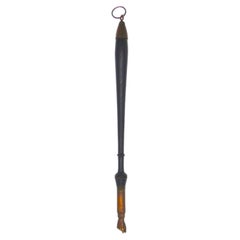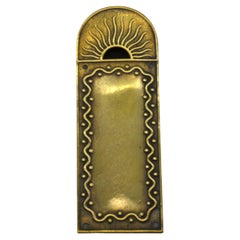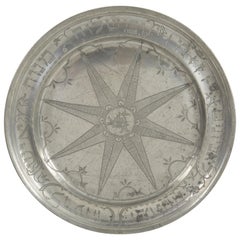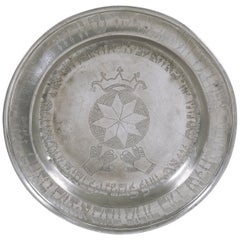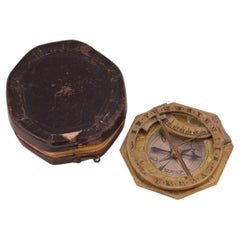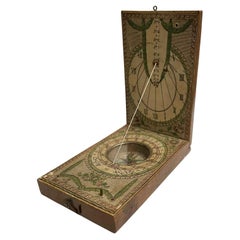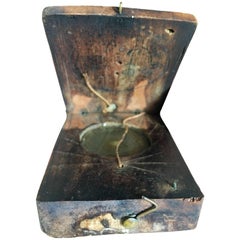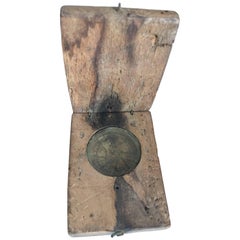Items Similar to A German Combination Compass With Sundial
Want more images or videos?
Request additional images or videos from the seller
1 of 7
A German Combination Compass With Sundial
About the Item
An 18th century German combination compass and sundial, complete with its original box. The inside of the cloth and leather box is affixed with a medallion listing various cities along with their latitudes. The compass itself is made up of many different parts, including a free-floating needle encased within glass, around which are the cardinal directions written in abbreviated Latin. The frame is of gilt brass, ornately carved with brick and wave motifs. There are three folding elements atop the rest of the compass, including an arm with degree measurements, a sundial with a rotating needle bar, and a plum bob.
- Dimensions:Height: 3 in (7.62 cm)Width: 3 in (7.62 cm)Depth: 0.4 in (1.02 cm)
- Materials and Techniques:
- Place of Origin:
- Period:
- Date of Manufacture:18th Century
- Condition:Wear consistent with age and use.
- Seller Location:New York, NY
- Reference Number:1stDibs: LU5281239817362
About the Seller
5.0
Recognized Seller
These prestigious sellers are industry leaders and represent the highest echelon for item quality and design.
Established in 2006
1stDibs seller since 2020
100 sales on 1stDibs
Typical response time: 10 hours
- ShippingRetrieving quote...Ships From: New York, NY
- Return PolicyA return for this item may be initiated within 3 days of delivery.
Authenticity Guarantee
In the unlikely event there’s an issue with an item’s authenticity, contact us within 1 year for a full refund. DetailsMoney-Back Guarantee
If your item is not as described, is damaged in transit, or does not arrive, contact us within 7 days for a full refund. Details24-Hour Cancellation
You have a 24-hour grace period in which to reconsider your purchase, with no questions asked.Vetted Professional Sellers
Our world-class sellers must adhere to strict standards for service and quality, maintaining the integrity of our listings.Price-Match Guarantee
If you find that a seller listed the same item for a lower price elsewhere, we’ll match it.Trusted Global Delivery
Our best-in-class carrier network provides specialized shipping options worldwide, including custom delivery.More From This Seller
View AllA German Wood and Brass Torah Pointer
Located in New York, NY
A German Wood and Brass Torah Pointer.
This Torah Pointer is made of wood and brass and painted black, unlike most Torah pointers which were made in Germa...
Category
20th Century German Religious Items
Materials
Brass
A Brass Mezuzah Case, Germany Circa 1915
Located in New York, NY
An Early Art Nouveau Brass Mezuzah Case made in Germany Circa 1915.
Art Nouveau is an ornamental art style that lasted from around 1890 to 1910 in Europe...
Category
Vintage 1910s German Art Nouveau Religious Items
Materials
Brass
18th Century German Pewter Purim Plate
Located in New York, NY
Pewter Purim dish, Germany, late 18th century.
The outer rim has wriggle-work engraving stating “and of sending portions one to another and gifts to the poor” (Esther 9:22). Interspersed between some of the words are depictions of foliage and flowers. Large
decorative star in which the very center has three interlocking fish. This dish was used for the custom of sending gifts of food to friends or neighbors during Purim. In Central Europe, nuts and candied or dried fruit were the usual treats extended. The astrological symbol of the month of Adar, in which Purim falls out on, are fish, which is why that is featured in the center.
18th century pewter Purim dishes are much more scarce than 18th century pewter Passover...
Category
Antique Mid-18th Century German Religious Items
Materials
Pewter
19th Century German Pewter Passover Plate
Located in New York, NY
German Passover Pewter plate dated 1825.
The plate with raised rim engraved in Hebrew with the Order of the Seder of Passover, In center, geometric design, surrounded by Hebrew text...
Category
Antique 1820s German Religious Items
Materials
Pewter
A German Anti-Semitic Beer Stein, Circa 1890
Located in New York, NY
This beer stein has detailed displays that open the window into the dark history of anti-Semitism that existed in Europe in the 19th century. It was made in a town called Hohr-Grenzh...
Category
Antique 1890s German Historical Memorabilia
Materials
Pewter
18th Century German Pewter Passover Plate
Located in New York, NY
Pewter passover tray, Germany, 18th century.
The outer rim has wriggle- work engraving of the order of the Seder service, along with a pair of birds fl...
Category
Antique Late 18th Century German Religious Items
Materials
Pewter
You May Also Like
Sundial and Compass with Case, Schrettegger, Johan, Augsburg, Germany, Ca 1800
Located in Madrid, ES
Sundial and compass with case. Bronze. SCHRETTEGGER, Johan. Augsburg, Germany, around 1800.
Sundial with a polygonal shape made of bronze, engraved with plant elements on the front,...
Category
Antique Late 18th Century German Neoclassical Scientific Instruments
Materials
Bronze, Other
18th Century Diptych Portable Sundial And Compass by German Beringer
By David Beringer
Located in Milano, MI
Antique 18th Century Diptych Sundial and Compass a portable wooden boxwood sundial with compass, of German origin, by David Beringer, Nuremberg, dating back to the 1790 circa, in good age related condition, with signs of wear consistent with age and use.
David Beringer (1756 – 1821) was a German scientific instrument maker and craftsman active in Nuremberg and famous for his cubic wooden sundials visible in Metropolitan Museum of Art di New York.
A portable sundial...
Category
Antique Late 18th Century German Scientific Instruments
Materials
Brass
19th Century Compass and Sundial Together
Located in Miami, FL
19th century compass and sundial together.
Category
Antique Late 19th Century French Baroque Scientific Instruments
Materials
Wood
19th Century, Compass and Sundial Together
Located in Miami, FL
19th century, compass and sundial together.
Category
Antique Late 19th Century French Baroque Scientific Instruments
Materials
Wood
Compass with Pocket Sundial, with Case, Bronze, Butterfield, Michael '1635-1724'
Located in Madrid, ES
Compass with pocket sundial, with case. Bronze. BUTTERFIELD, Michael (1635-1724). Paris, circa 1700.
Pocket sundial made of engraved metal, with a gno...
Category
Antique Early 18th Century French Neoclassical Scientific Instruments
Materials
Metal, Bronze, Other
19th Century French Table Sundial And Compass
Located in Firenze, IT
Shipping policy
No additional costs will be added to this order.
Shipping costs will be totally covered by the seller (customs duties included).
Brass sundial with folding gnoman. ...
Category
Antique Late 19th Century French Napoleon III Scientific Instruments
Materials
Brass
Recently Viewed
View AllMore Ways To Browse
Antique Brick
Antique Cardinal
Antique Bobbers
Brass Box Germany
Antique Ornate Frame Brass
Antique Needle Box
Antique Sundial Sundials
Antique Sundial
Antique Sundials
Compass In A Box
Brass Box Compass
Antique Box Compass
Compass And Sundial
Compass Sundial
Antique Compass Sundial
Antique Brass Sundials
Antique Brass Sundial Compass
Scientific Chart






